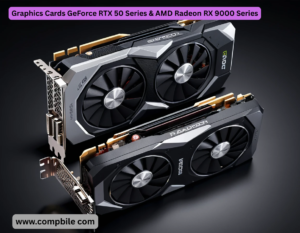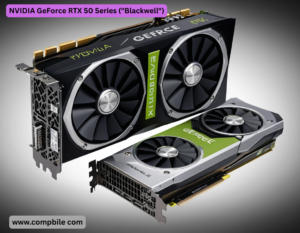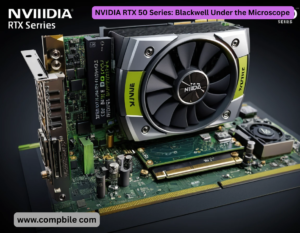Graphics Cards GeForce RTX 50 Series & AMD Radeon RX 9000 NVIDIA’s GeForce RTX 50 Series and AMD’s Radeon RX 9000 Series have not been officially announced, but rumors, leaks, and industry trends provide some insight into what we can expect.
NVIDIA GeForce RTX 50 Series Blackwell
- Expected Launch: Late 2024 – Early 2025
- Architecture: Blackwell (Next-gen after Ada Lovelace)
- Process Node: TSMC 3nm (N3 or N3E)
Key Features Rumored
- Significant ray tracing and AI performance improvements (DLSS 4.0?)
- Higher CUDA core counts & faster GDDR7 memory
- Architecture: RDNA 4 (Next-gen after RDNA 3)
- Process Node: TSMC 4nm or 3nm
Key Features (Rumored):
- Focus on efficiency & improved ray tracing
- Next-gen Infinity Cache & GDDR7 memory
- Possible chip let redesign for higher-end models
- PCIE 5.0 support
- Potential models: RX 9900 XT, RX 9800 XT, etc.
- AMD RX 9000 Series may focus on price-to-performance and efficiency, possibly undercutting NVIDIA.
- Battle for 4K/8K & Next-Gen Ray Tracing: Both will push boundaries, but NVIDIA may retain the performance crown.
- Pricing: High-end models (RTX 5090/RX 9900 XT) could exceed $1,500–$1,800.
NVIDIA GeForce RTX 50 Series (“Blackwell”)
- Architecture & Process Node
- Codename: Blackwell (successor to Ada Lovelace).
- Process Node: TSMC 3nm (N3E) – denser and more efficient than Ada’s 4N.
- Key Innovations:
- New SM (Streaming Multiprocessor) Design: Higher FP32 throughput, improved ray tracing cores (RT Core 4.0?), and next-gen Tensor Cores (AI acceleration).
- DLSS 4.0: Potential AI upscaling/path tracing upgrades (e.g., frame generation without artifacts).
- GDDR7 Memory: Up to 32Gbps+ speeds (vs. 24Gbps GDDR6X in RTX 4090), possibly 28-32GB on flagship.
- PCIE 5.0 Support: Future-proofing for next-gen motherboards.
Performance Targets (Speculative)’
- RTX 5090:
- 2.5–3x rasterization performance over RTX 4090.
- 3–4x ray tracing performance (with RT Core 4.0).
- 36 TFLOPs+ FP32 compute (vs. RTX 4090’s ~82 TFLOPs in DLSS/RT workloads).
- RTX 5080:
- Power Efficiency:
- Despite TSMC 3nm, TDPs may rise (e.g., RTX 5090 at 450–500W) for max performance.
Potential Weaknesses
- Price: RTX 5090 could hit $1,800–$2,000 (NVIDIA’s premium positioning).
- Size: May require 4-slot coolers due to heat density.
AMD Radeon RX 9000 Series (“RDNA 4”)
- Architecture & Process Node
- Codename: RDNA 4 (successor to RDNA 3).
- Process Node: TSMC 4nm (N4P) or 3nm (N3E) – focus on efficiency.
- Key Innovations:
- Chip let Design Refinement: Better utilization of MCD (Memory Cache Die) and GCD (Compute Die).
- Ray Tracing Overhaul: RT performance closer to NVIDIA (RDNA 3 lagged behind).
- GDDR7 Memory: 20-24GB on flagship, 384-bit bus.
- Hybrid Compute: Better synergy with Ryzen AI (XDNA 2) for AI workloads.
Performance Targets (Speculative)
- RX 9900 XT:
- ~2x RX 7900 XTX in rasterization.
- 2.5x ray tracing performance (if AMD fixes RDNA 3’s RT weaknesses).
- 48 TFLOPs+ FP32 compute (vs. 7900 XTX’s ~61 TFLOPs in AI workloads).
- RX 9800 XT:
- RTX 4080-tier performance at lower price.
- Power Efficiency:
- TDPs may stay flat (350W for flagship) thanks to node shrink.
Potential Weaknesses
- Ray Tracing: May still trail NVIDIA’s dedicated hardware.
- Software: FSR 4 needs to match DLSS 4.0’s AI prowess.
- What’s at Stake?
- NVIDIA’s Goals:
- Push “AI PC” ecosystem with Blackwell’s Tensor Cores.
- AMD’s Goals:
- Close ray tracing gap and compete on price-to-performance.
- Leverage chip let design for cost savings.
Should You Wait?
- For Enthusiasts: Yes, if you want 4K 144Hz+ or 8K gaming.
- For Budget Buyers: RTX 40/RX 7000 prices will drop after launch.
- For AI/Content Creators: RTX 50’s Tensor Cores may be worth waiting for.
NVIDIA RTX 50 Series: Blackwell Under the Microscope
- Core Architectural Upgrades
- Next-Gen Streaming Multiprocessors (SMs):
- FP64 & AI Focus: Blackwell is rumored to emphasize FP64 (double-precision) performance, hinting at a unified architecture for gaming and compute (like data center GPUs).
- RT Core 4.0: Dedicated hardware for path tracing (full-scene ray tracing) with reduced noise, possibly integrating AI denoising directly into cores.
- Tensor Core 4.0: Support for FP8 precision (2x faster AI training/inference vs. FP16 in Ada). Could enable real-time neural rendering in games.
Memory Hierarchy Revolution
- GDDR7 Confirmed:
- Bandwidth: 32 Gb PS/pin (vs. 24 Gb PS GDDR6X in RTX 4090) → 1.5TB/s+ on a 384-bit bus.
- L2 Cache: Up to 128MB (vs. 72MB in RTX 4090) to feed wider cores.
- Power & Thermal Challenges
- 3nm Efficiency Gains Offset by Performance Push:
- RTX 5090 may hit 500–600W in “OC” variants (requiring 16-pin 12V-2×6 power connector).
- Vapor Chamber 2.0 Cooling: Expect hybrid liquid-air coolers from AIBs.
- NVIDIA’s Secret Weapon: AI Integration
- DLSS 4.0:
- Frame Generation 2.0: AI-predicted frames (not interpolated) to reduce latency.
- Texture Synthesis: AI-generated high-res textures in real time (like Nvidia’s “Neural Texture Compression”).
- “AI NPCs”: Blackwell could leverage Tensor Cores for on-GPU LLM inference (e.g., smarter in-game NPCs).
AMD RX 9000 Series: RDNA 4’s Make-or-Break Moment
- Graphics Cards GeForce RTX 50 Series & AMD Radeon RX 9000 Chip let Design Evolved
- 3nm GCD + 6nm MCD: Better yields, but potential latency trade-offs.
- Ray Tracing: AMD’s Big Bet
- “RT Accelerators” (RTA): Dedicated hardware for BVH traversal (finally matching NVIDIA’s RT Core efficiency).
- Hybrid Rendering: Combining rasterization + RT + AI upscaling (FSR 4) to close the gap.
- FSR 4 vs. DLSS 4.0
- FSR 4’s AI Pivot: AMD is finally adding AI-trained temporal upscaling (like DLSS), but may lack dedicated Tensor Core hardware.
- Open-Source Advantage: FSR 4 could work on any GPU (including NVIDIA), but quality may lag behind DLSS.
The High-End Question
- Will AMD Compete at the Top?
- Rumors suggest RDNA 4 may skip the ultra-high-end (no RX 9900 XT?) to focus on mid-range (RX 9800 XT as flagship).
- Strategy: Win on price/perf ($999 RX 9800 XT vs. $1,800 RTX 5090).
Market Impact & Strategic Moves
- Graphics Cards GeForce RTX 50 Series & AMD Radeon RX 9000 NVIDIA’s Playbook
- Premium Pricing: RTX 5090 could hit $2,000, pushing enthusiasts toward cheaper RTX 4080/70.
- AMD’s Counter
- Value Proposition: RX 9800 XT at $999 with 90% of RTX 5080 performance.
- APU Synergy: Ryzen 9000 + RX 9000 laptops could dominate thin-and-light gaming.
- Wildcards
- GDDR7 Supply: Early adoption could lead to shortages.
NVIDIA GeForce RTX 50 Series (“Blackwell”) – The AI & Ray Tracing Juggernaut
- A. Blackwell GPU Architecture – What’s New?
- Process Node: TSMC 3nm (N3E) – ~25% more transistors than Ada Lovelace (RTX 40).
- SM (Streaming Multiprocessor) Overhaul:
- FP64 Support Returns (for compute workloads, like AI/rendering).
- RT Core 4.0: Hardware-accelerated path tracing (full-scene RT with less noise).
- Tensor Core 4.0: FP8 precision (2x AI speed vs. FP16 in Ada).
- Memory System:
- GDDR7 Confirmed – Up to 32Gbps (vs. 24Gbps GDDR6X in RTX 4090).
- L2 Cache Doubled (128MB vs. 72MB in RTX 4090).
- PCIE 5.0 Support (future-proofing for next-gen SSDs/CPUs).
NVIDIA’s Secret Weapons
- DLSS 4.0:
- Frame Generation 2.0 (AI-predicted frames, not interpolated).
- Neural Texture Compression (AI-upscaled textures in real time).
- AI NPCs: Tensor Cores could run on-GPU LLMs (smarter in-game characters).
- Professional Crossover: Blackwell may share DNA with data center GPUs, making it a beast for AI/rendering.
- D. Potential Downsides
- Power Consumption: RTX 5090 could hit 500–600W (liquid cooling recommended).
- Price: RTX 5090 may cost $1,800–$2,000 (NVIDIA’s premium tax).
Get article on pdf file….Click now
…………Graphics Cards GeForce RTX 50 Series & AMD Radeon RX 9000………



